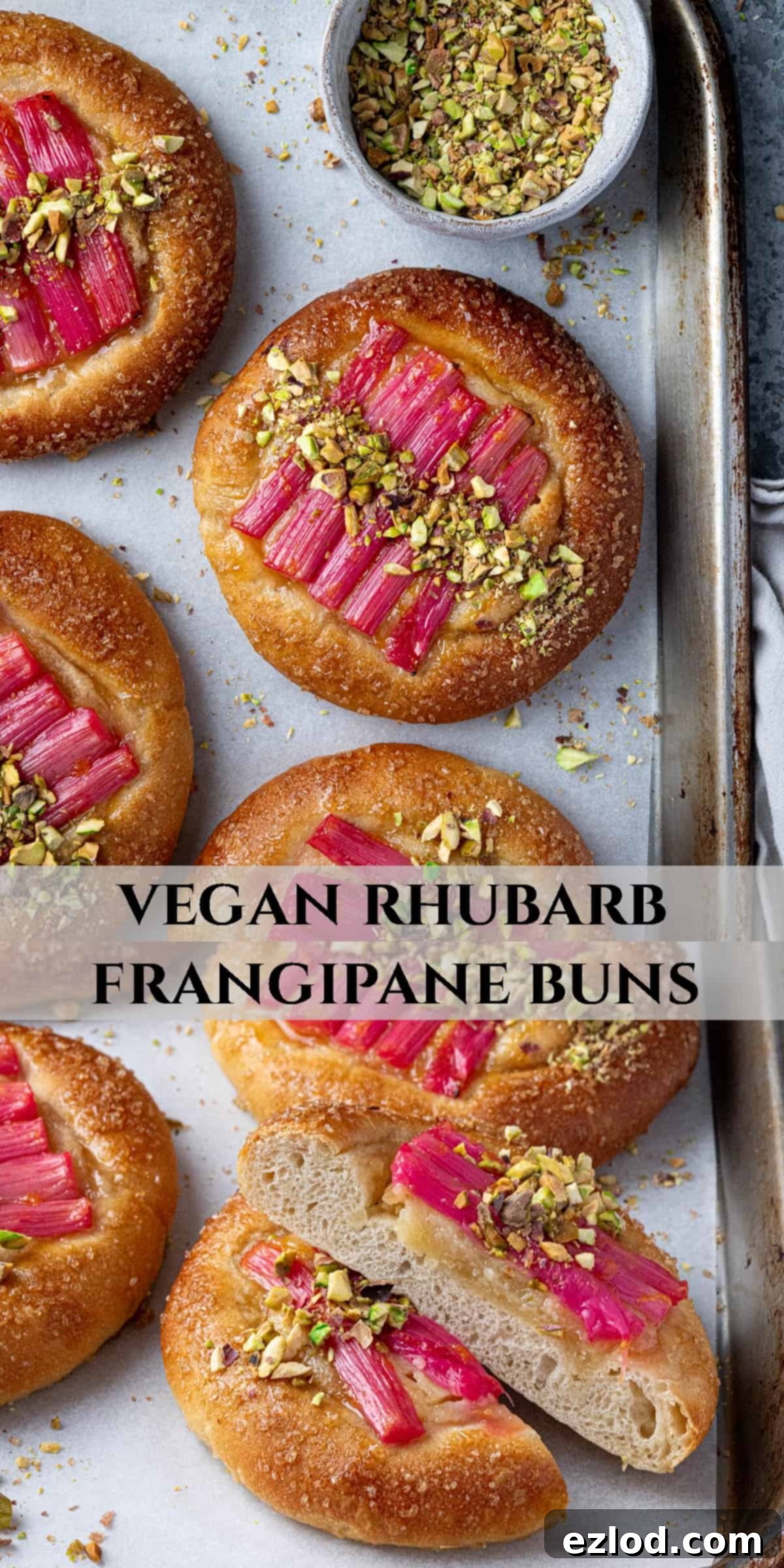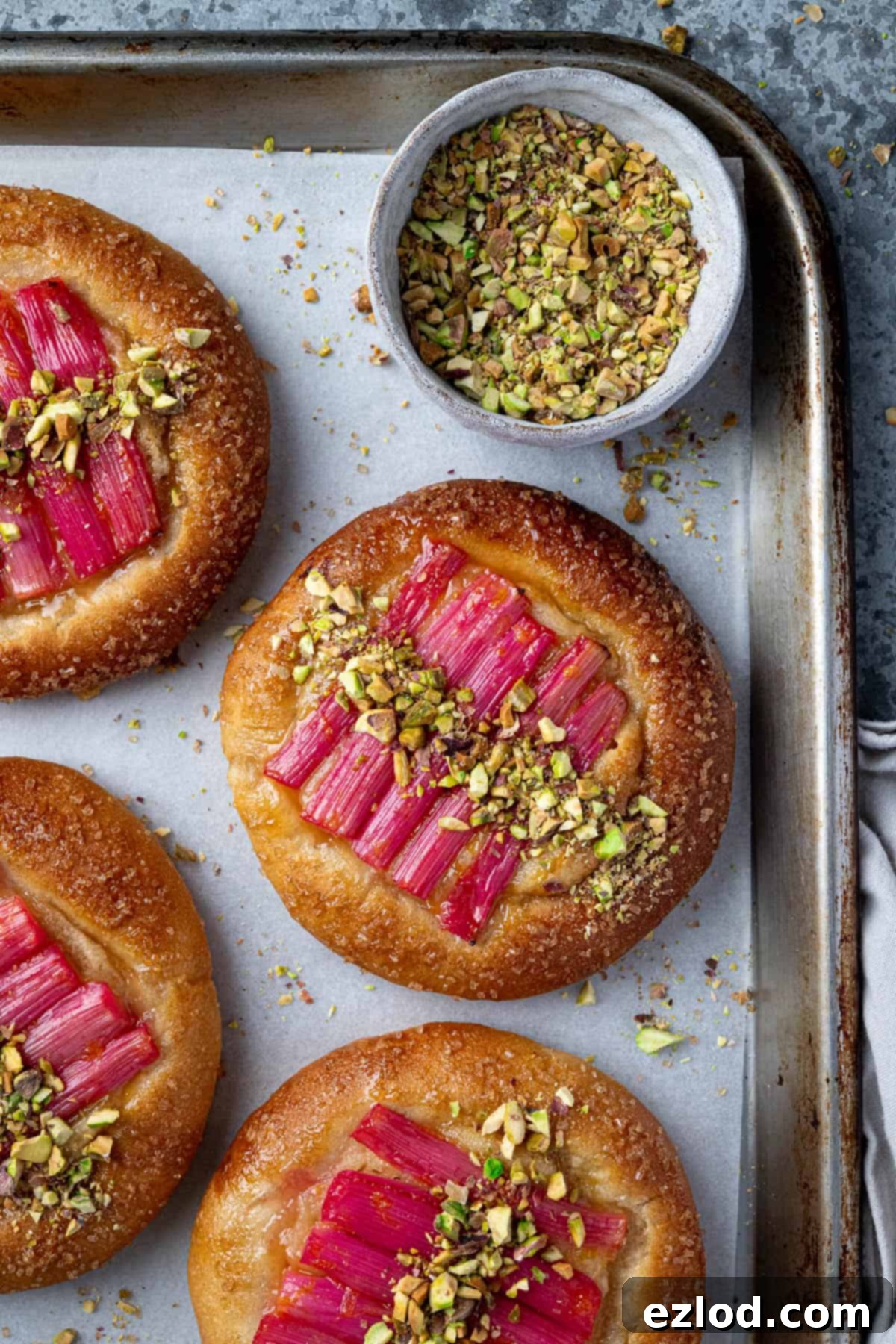Vegan Rhubarb Frangipane Buns: A Delightfully Fluffy & Flavorful Plant-Based Treat
Discover the ultimate recipe for vegan rhubarb frangipane buns – a truly delightful individual-sized pastry featuring a soft, fluffy, brioche-like bread base generously topped with a rich almond frangipane and perfectly roasted rhubarb. These exquisite buns offer a symphony of flavors that are both richly satisfying and beautifully balanced, avoiding excessive sweetness. They are an ideal choice for an elevated breakfast, a sophisticated brunch, or a luxurious snack, and the best part? They are entirely plant-based and incredibly easy to make at home.
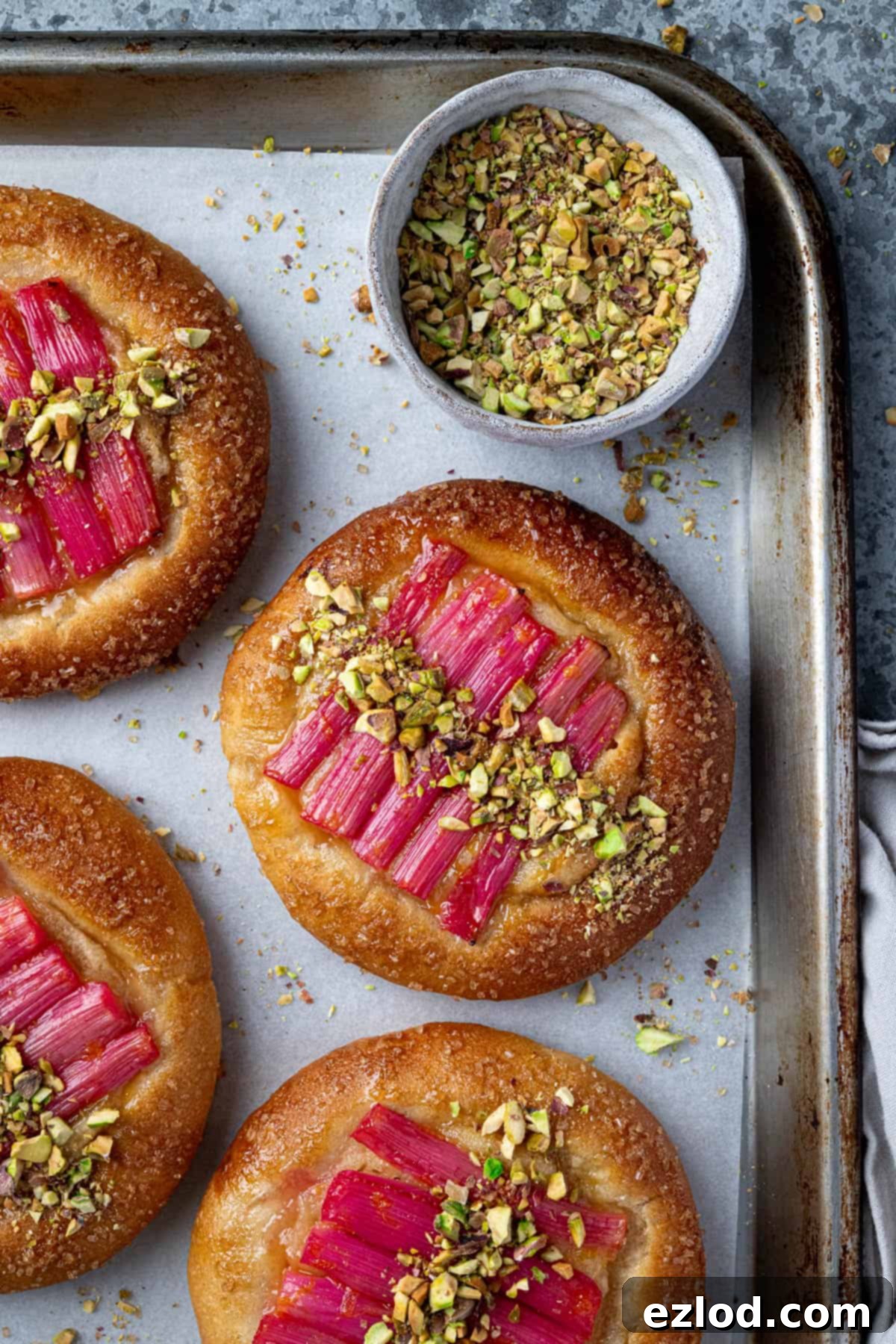
These vegan rhubarb frangipane buns stand out as one of the most aesthetically pleasing and utterly delicious creations I’ve ever baked. Their vibrant appearance and complex flavors make them a true showstopper, perfect for impressing guests or simply treating yourself to something special.
The secret to their exceptional texture lies in the tangzhong dough used for the base. This Japanese water roux method yields an incredibly soft, moist, and fluffy brioche-like bread, achieving that desirable richness with significantly less fat than traditional brioche recipes. The tangzhong method ensures the buns stay fresh and tender for longer, a huge bonus for any baked good.
Before baking, each bun (or tart, as they sometimes resemble) is generously crowned with an eggless almond frangipane and slices of rhubarb that have been beautifully roasted with a hint of orange. This exquisite combination of a tender, airy bread, the luscious and creamy frangipane, and the bright, tangy notes of the rhubarb creates an unforgettable taste experience. Every bite offers a harmonious blend of textures and flavors that is simply irresistible.
While entirely optional, a delicate scattering of chopped pistachios elevates these buns from homemade treats to bakery-quality masterpieces. The bright green of the pistachios against the pink rhubarb and golden frangipane adds a stunning visual contrast, and their subtle crunch introduces an appealing textural element, complementing the soft fillings perfectly. This small addition makes them truly stand out on any table.
The visual inspiration for these unique buns comes from Edd Kimber’s renowned rhubarb and custard brioche tarts. However, it’s important to note that while the concept sparked my creativity, the recipe itself is entirely my own original creation, meticulously crafted to be fully vegan and optimized for an unparalleled taste and texture.
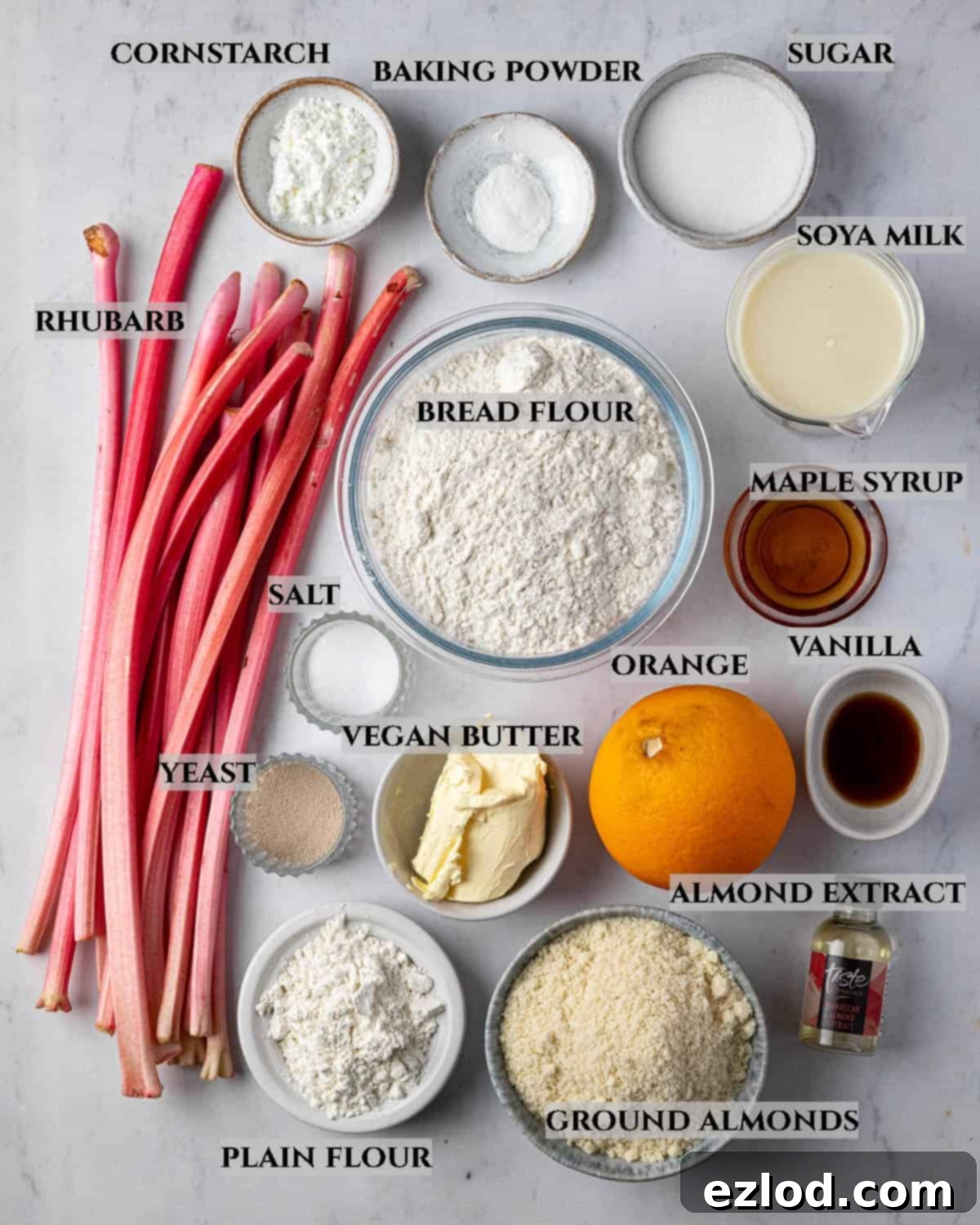
Essential Ingredient Insights for Perfect Vegan Rhubarb Frangipane Buns
Crafting these delectable vegan rhubarb frangipane buns starts with understanding the role of each ingredient. Here’s a detailed breakdown to ensure your baking success:
Bread flour: White bread flour is indispensable for achieving the signature soft, fluffy, and wonderfully chewy texture that defines these brioche-like buns. Its higher protein content allows for excellent gluten development, which is critical for a light and airy crumb. While plain (all-purpose) flour can be used in a pinch, be aware that the resulting texture may not be quite as springy or robust. I strongly advise against using wholemeal flour, as its higher bran content will significantly inhibit gluten formation, leading to a much denser and less appealing bun.
Instant yeast: For convenience and consistent results, I always recommend instant yeast when baking bread. It can be mixed directly into the dry ingredients without requiring prior activation in liquid, streamlining the process and reducing potential errors. Ensure your yeast is fresh and within its expiration date for optimal rising power.
Salt: Salt is far more than just a seasoning in bread; it’s a fundamental ingredient that enhances flavor, controls yeast activity, and strengthens gluten structure. Omitting salt will result in a bland, underdeveloped dough and a flat-tasting final product. Do not skip it!
Non-dairy milk: Soy milk is my top recommendation for baking due to its higher protein content, which most closely mimics the properties of dairy milk in recipes. This contributes to better structure and a richer flavor in your baked goods. However, any unsweetened variety of non-dairy milk will work effectively. Opt for an unsweetened version to maintain control over the sweetness level of your buns.
Vegan butter: For most baking applications, I typically suggest using a block-style vegan butter for its superior texture and performance. For this recipe, however, a good quality tub variety (like Flora Original, as mentioned) is perfectly acceptable, especially for incorporating into the dough. Crucially, avoid low-fat spreads, as they contain too much water and not enough fat to produce the desired richness and texture.
Sugar: Caster sugar or granulated sugar are the preferred choices for both the dough and the frangipane. Their fine crystal structure dissolves easily, contributing to a smooth texture and even sweetness. Do not substitute with liquid sugars or artificial sweeteners, as these can drastically alter the dough’s consistency and the overall chemical balance of the recipe.
Ground almonds: This forms the delicious, nutty base of the frangipane. In the United States, ground almonds are often referred to as almond flour. Ensure you use finely ground almonds for the best, most uniform frangipane texture.
Cornstarch (Cornflour): I incorporate both plain flour and cornflour (cornstarch) into the frangipane mixture. The cornstarch plays a crucial role in helping the frangipane set properly, giving it a beautifully firm yet creamy consistency once baked.
Rhubarb: For a vibrant pink hue and a naturally sweeter, milder flavor, forced rhubarb is ideal. Its tender stalks break down beautifully during roasting, providing that signature tart-sweet balance against the rich frangipane. If forced rhubarb is unavailable, regular rhubarb will work, though it may be greener and slightly more tart.
Orange: Roasting the rhubarb with fresh orange zest and juice infuses it with a bright, aromatic citrus note that perfectly complements the rhubarb’s tartness. Blood orange would be a fantastic choice here, adding an even deeper color and a more complex, subtly floral flavor profile to the fruit topping.
Demerara sugar: This is an optional but highly recommended finishing touch. Sprinkling the buns with demerara (or turbinado) sugar before baking adds a lovely coarse texture and a sparkling, caramelized crust to the exposed dough, enhancing both appearance and taste.
Finally, I love to decorate my baked buns with a scattering of chopped roasted pistachios. The combination of pink rhubarb and green pistachios creates a visually stunning effect, reminiscent of high-end bakery treats. Beyond aesthetics, pistachios also introduce a pleasant crunch, offering a delightful textural contrast to the soft bun and creamy frangipane. This step is entirely optional, but highly encouraged for that extra flair.
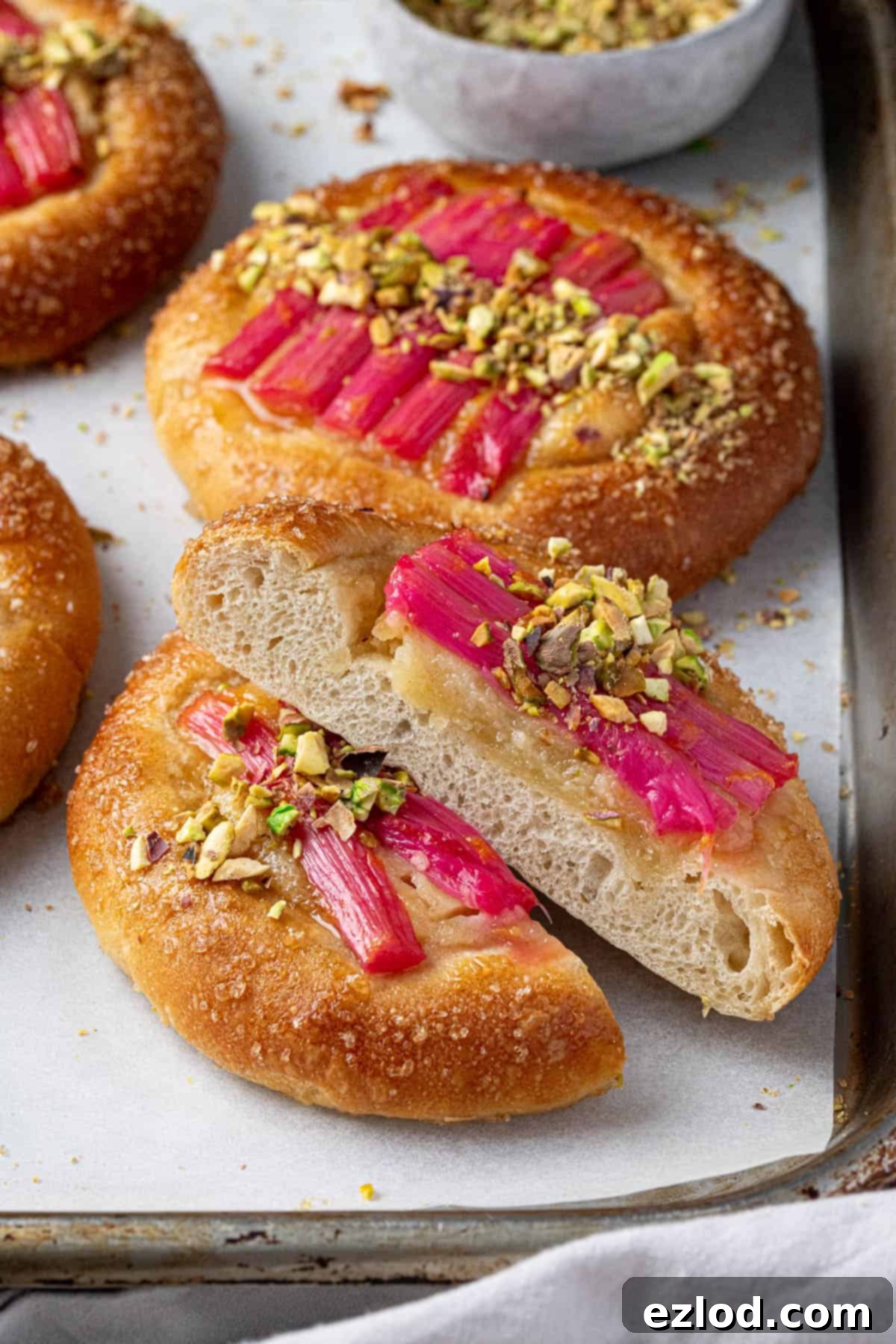
How To Master These Vegan Rhubarb Frangipane Buns: A Step-by-Step Guide
(Full detailed measurements and precise instructions for this recipe can be found conveniently located in the recipe card at the bottom of this page. This section offers a narrative overview of the process.)
Creating these exquisite vegan rhubarb frangipane buns involves a few distinct stages, each contributing to their overall perfection. Let’s walk through the process:
Step 1: Preparing the Tangzhong. Begin by making the tangzhong, the crucial roux that gives these buns their incredible softness and extended freshness. In a small saucepan, combine a portion of the bread flour with a gradual addition of non-dairy milk, whisking continuously to prevent lumps. Place this mixture over a medium-low heat, continuing to whisk until it transforms into a thick, pudding-like paste. This brief cooking gelatinizes the starch in the flour, allowing it to absorb and retain more liquid, which is key to the dough’s tender texture.
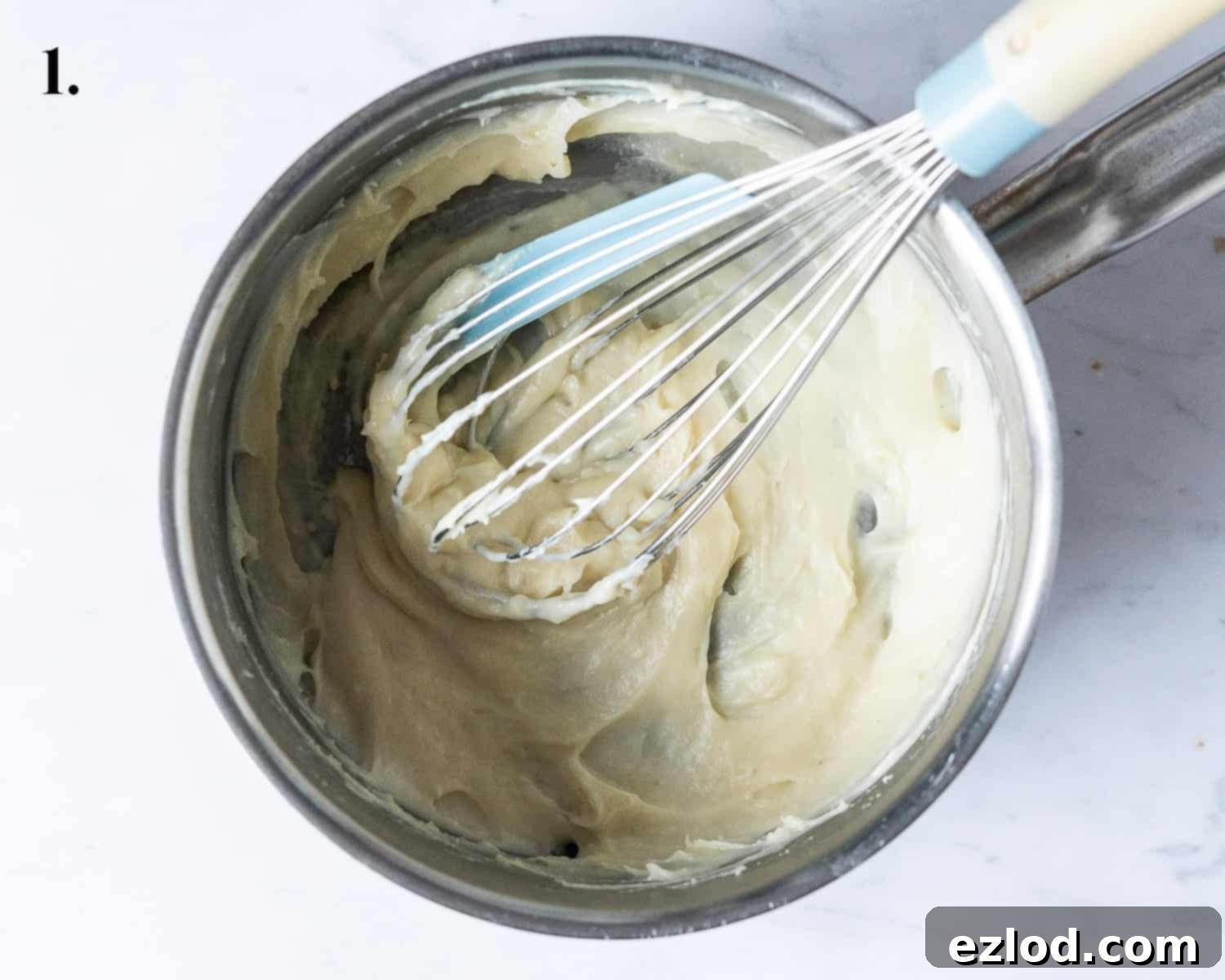
Step 2: Crafting the Dough. Once your tangzhong is ready, scrape it into the bowl of a stand mixer fitted with a dough hook. Immediately pour the remaining cold non-dairy milk over it; this helps to cool the tangzhong down, preventing it from overheating and potentially harming the yeast. Add the sugar, vanilla extract, salt, the rest of the bread flour, and finally the instant yeast. Mix on a low speed until a shaggy dough forms, then increase the speed to medium and knead for about 10 minutes until the dough becomes smooth, elastic, and visibly stretchy. Next, incorporate the softened vegan butter, kneading for another 5 minutes until the butter is fully absorbed, and the dough feels smooth, elastic, and no longer greasy. The dough should be soft and slightly sticky but should pull cleanly from the sides of the bowl. If it seems too wet, add flour sparingly, a tablespoon at a time, being careful not to over-flour and dry out the dough.
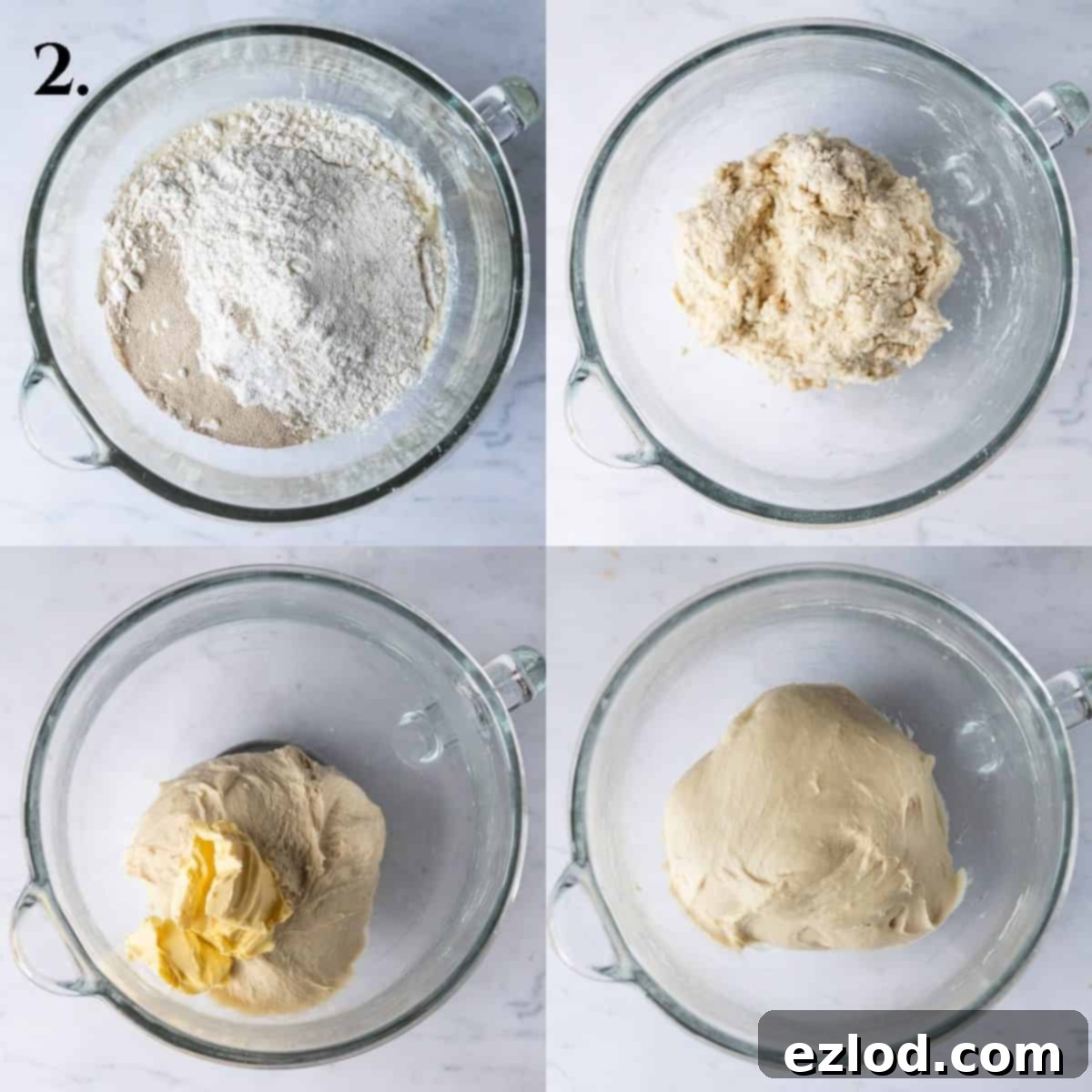
Step 3: First Rise. Transfer the kneaded dough into a lightly oiled bowl, ensuring it’s well-coated to prevent sticking. Cover the bowl securely and place it in a warm environment for its first proofing. This process typically takes 1-2 hours, or until the dough has noticeably doubled in size. Alternatively, for a deeper flavor development and to split your workload, you can let it rise slowly overnight in the refrigerator.

Step 4: Roasting the Rhubarb. While the dough is undergoing its first rise, prepare the vibrant rhubarb topping. Preheat your oven and cut the rhubarb into uniform pieces. Arrange them in a single layer in a roasting tin, then sprinkle with sugar and pour over the fresh orange juice. Roast for approximately 10 minutes, just until the rhubarb softens slightly but still retains its shape. Overcooking can make it too mushy, which would be difficult to work with later. Set it aside to cool completely.
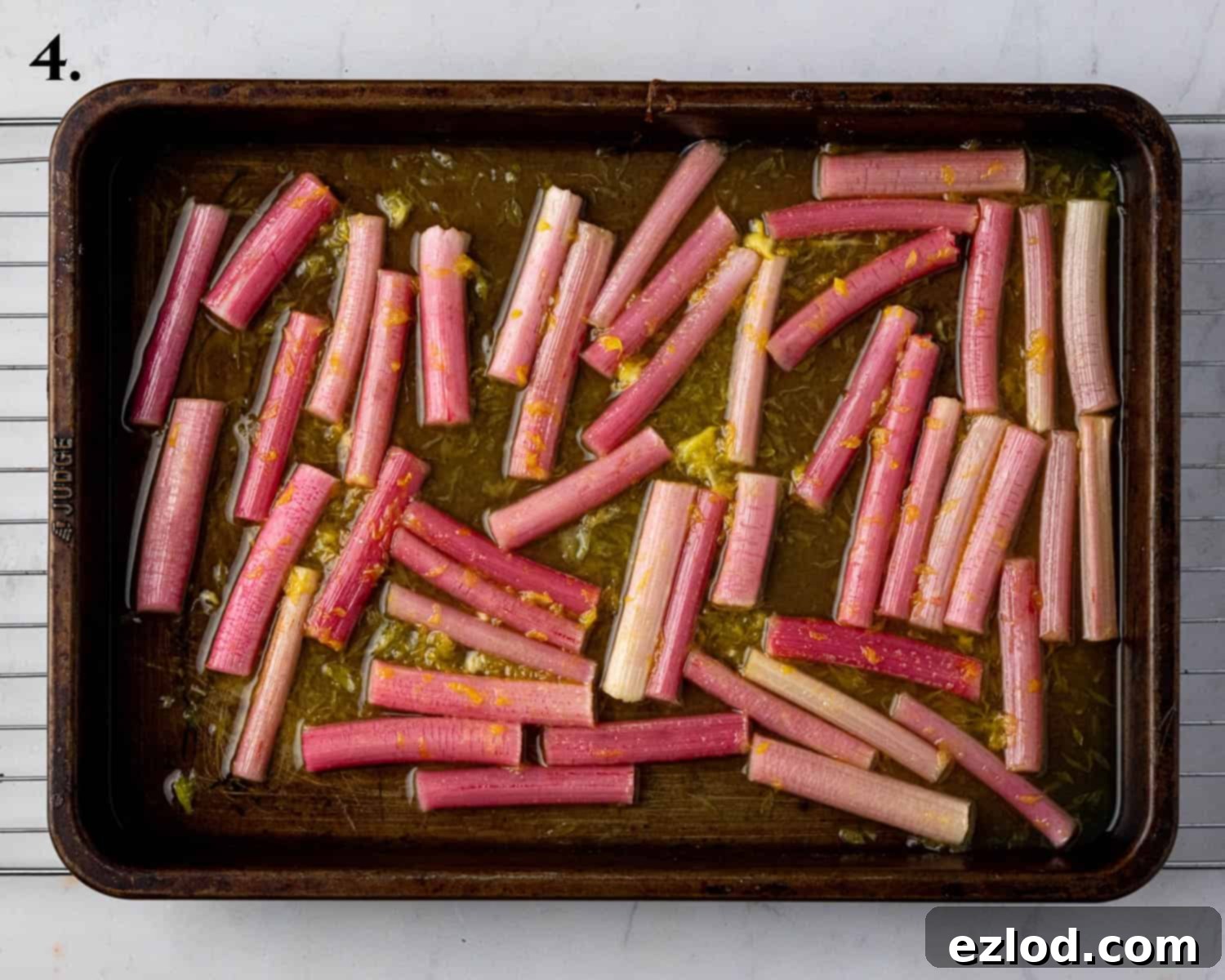
Step 5: Shaping the Buns. Once the dough has completed its first rise, gently punch it down to release the trapped air. Turn it out onto a lightly floured surface and divide it into 10 equal portions, ideally using a kitchen scale for precision. Roll each portion into a smooth ball. Using your hands, flatten each ball into a disc about 10 cm wide. Then, using your fingers or the bottom of a glass, create a deeper indentation in the center of each disc, leaving an elevated rim of about 2 cm around the edge. This hollow will perfectly cradle the frangipane and rhubarb.

Step 6: Second Rise. Arrange the shaped dough discs on two lined baking sheets, ensuring they are well-spaced to allow for expansion. Loosely cover them and let them rise again in a warm spot for about 30-45 minutes, or until visibly puffy. A good indicator that they’re ready is when a gentle press with your finger causes the dough to spring back slowly, leaving only a slight indentation. If it bounces back quickly, it needs more time; if it deflates, it’s over-proofed.
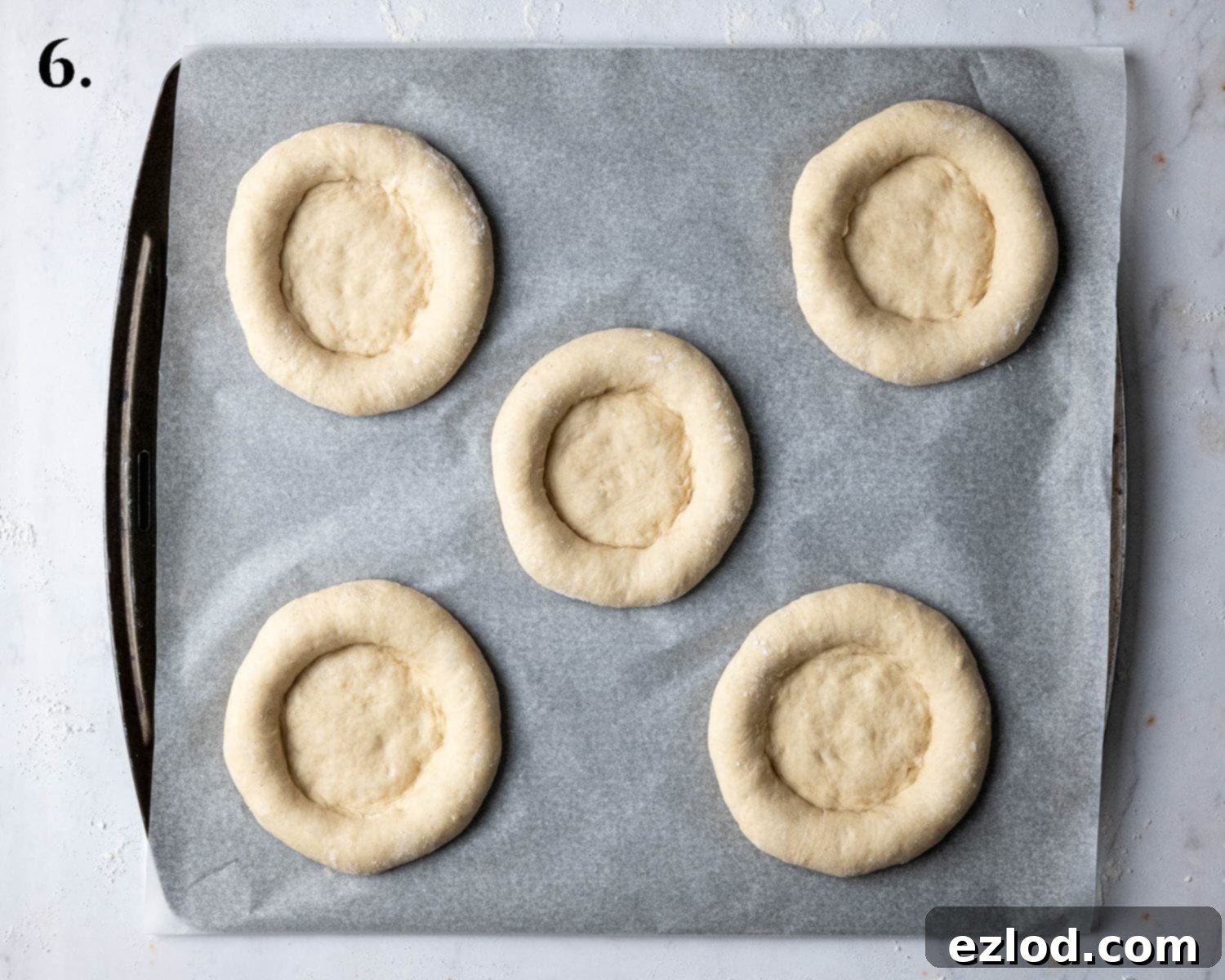
Step 7: Preparing the Frangipane. While the buns are on their second rise, prepare the luscious vegan frangipane. In a bowl, whisk together the ground almonds, plain flour, cornflour, baking powder, and sugar. Add the melted vegan butter, non-dairy milk, and almond extract. Stir with a balloon whisk until all ingredients are thoroughly combined and the mixture is smooth and creamy. This rich almond filling is eggless yet incredibly decadent.
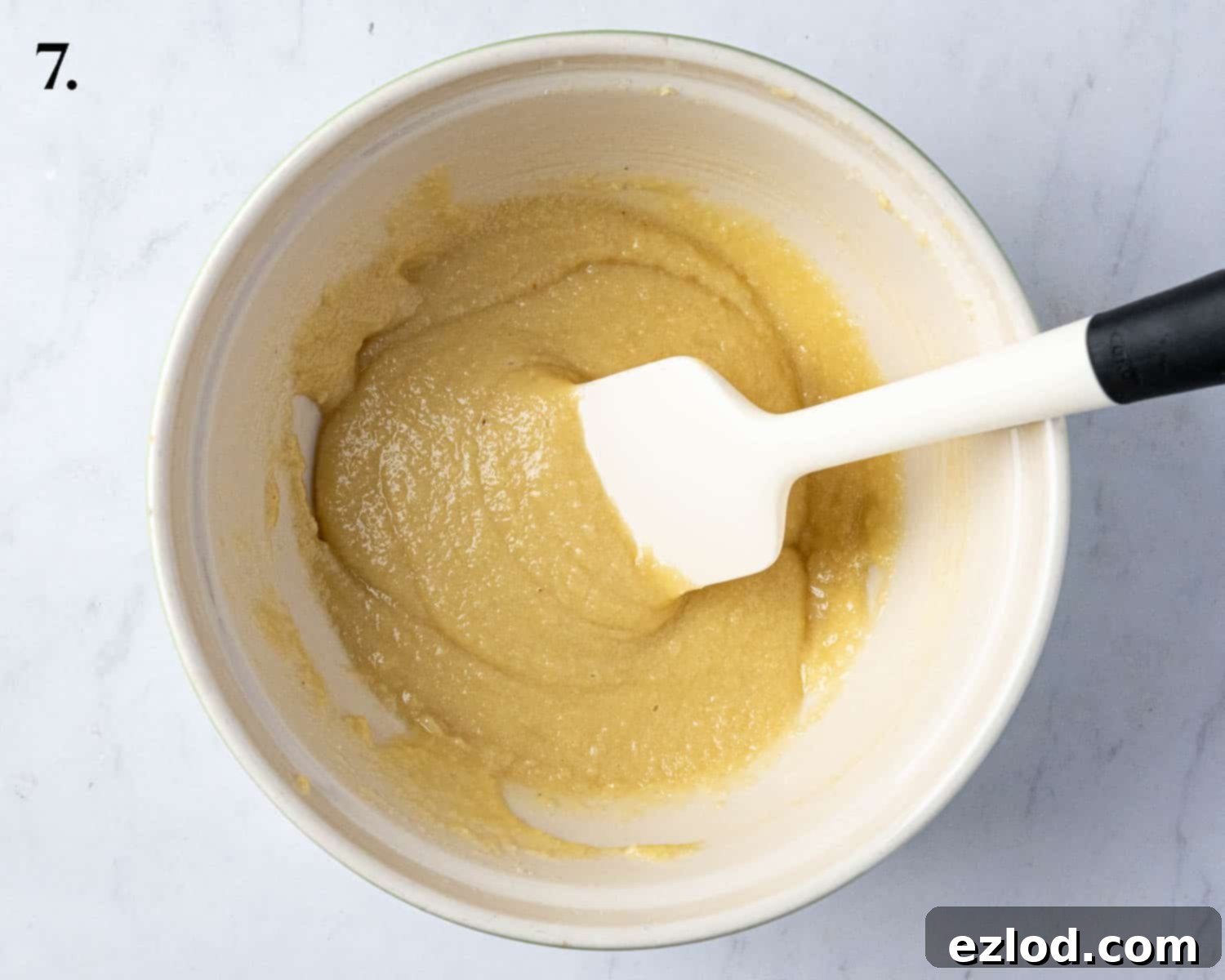
Step 8: Filling the Buns. Once the buns have risen sufficiently, carefully spoon the prepared frangipane into the hollows of each dough disc. Use the back of the spoon to gently spread the frangipane level, ensuring an even layer across the indentation. Be mindful not to disturb the delicate risen dough rim.
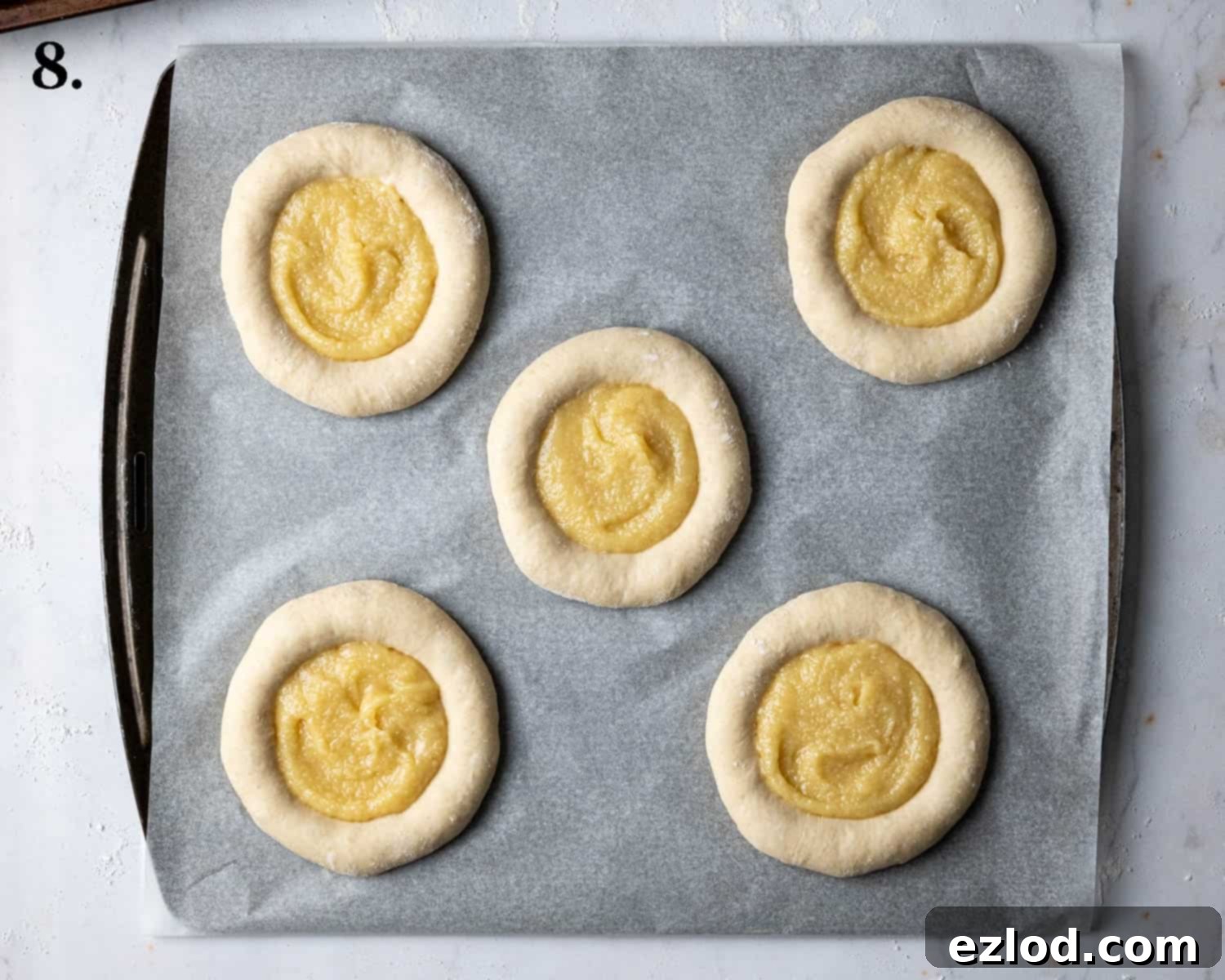
Step 9: Topping and Finishing. Artfully arrange the roasted rhubarb pieces on top of the frangipane in each bun, reserving any leftover juices from the rhubarb roasting for later. In a small bowl, whisk together a tablespoon of non-dairy milk and maple syrup. Gently brush this mixture onto the exposed dough rim of each bun. Finally, sprinkle generously with demerara sugar for a beautiful sparkle and a delightful hint of crunch once baked.
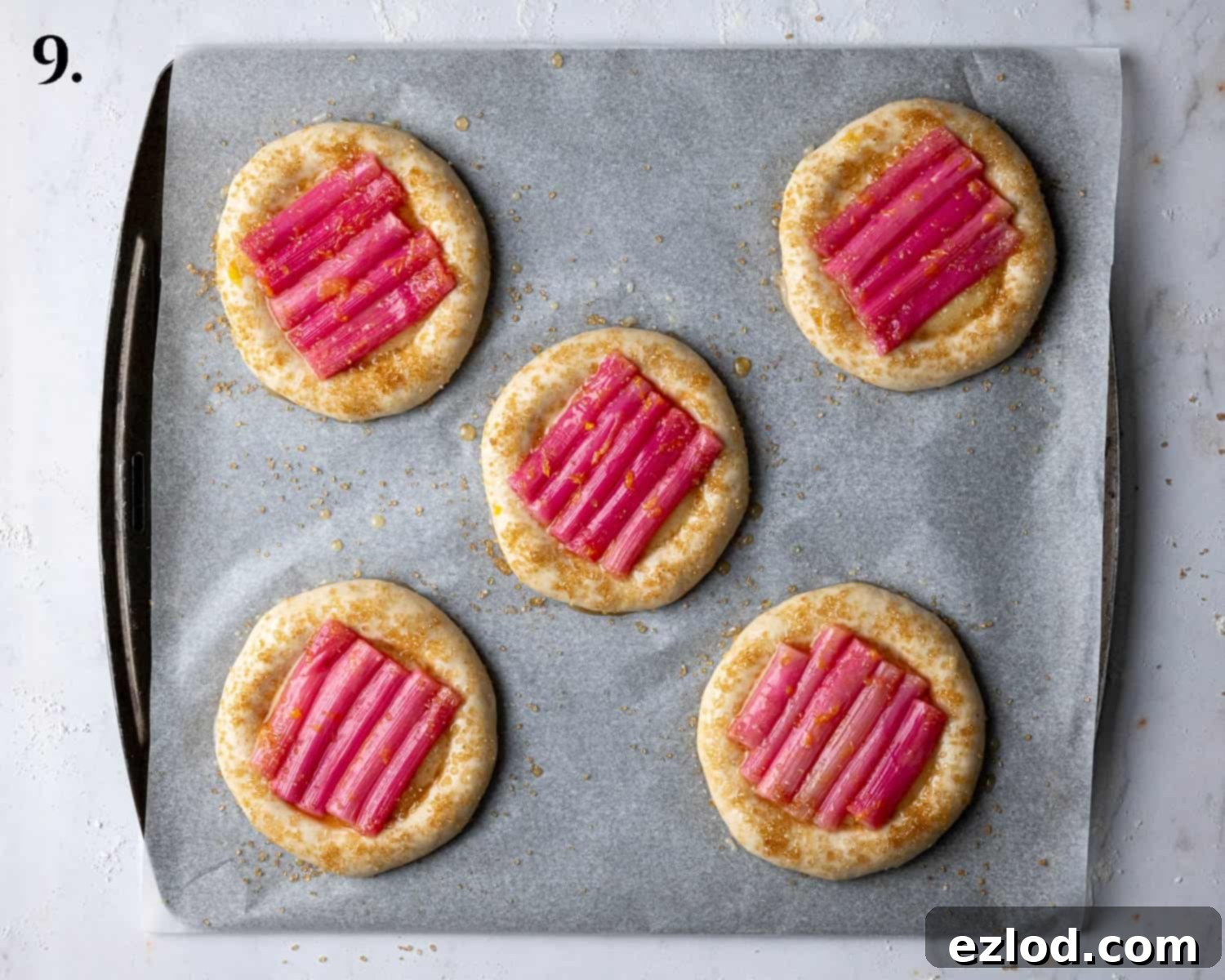
Step 10: Baking. Transfer the baking sheets to your preheated oven and bake for 20-25 minutes. The buns are ready when they turn a beautiful golden brown, indicating a perfectly cooked dough and a set, fragrant frangipane. While they bake, briefly simmer the reserved rhubarb juices in a small pan until slightly reduced; this will become your finishing glaze. Once baked, carefully slide the hot buns onto a wire cooling rack. Immediately brush the warm rhubarb with the reduced syrup for an extra layer of flavor and shine. For an optional flourish, scatter chopped roasted pistachios over the buns. Serve them warm for the best experience.
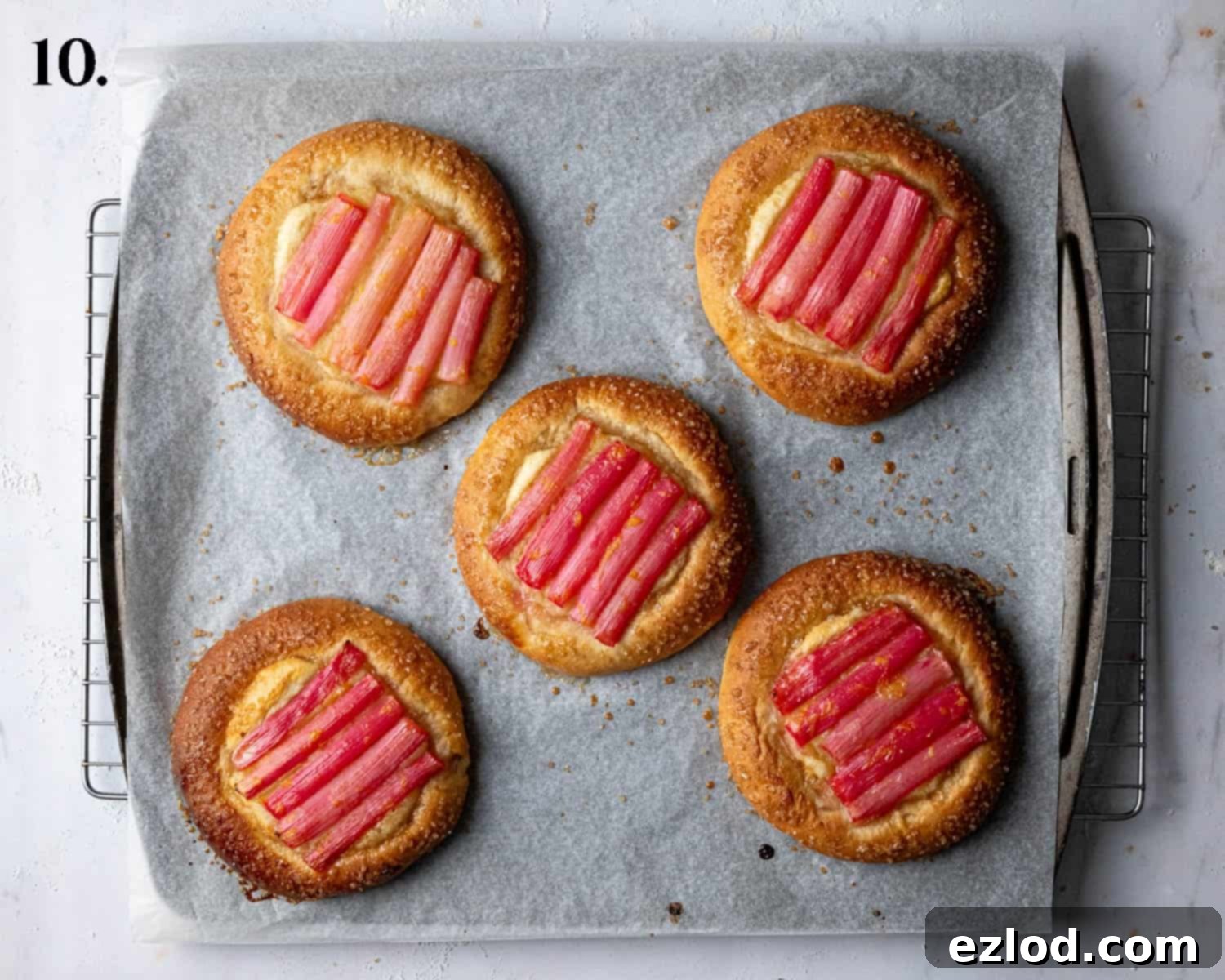
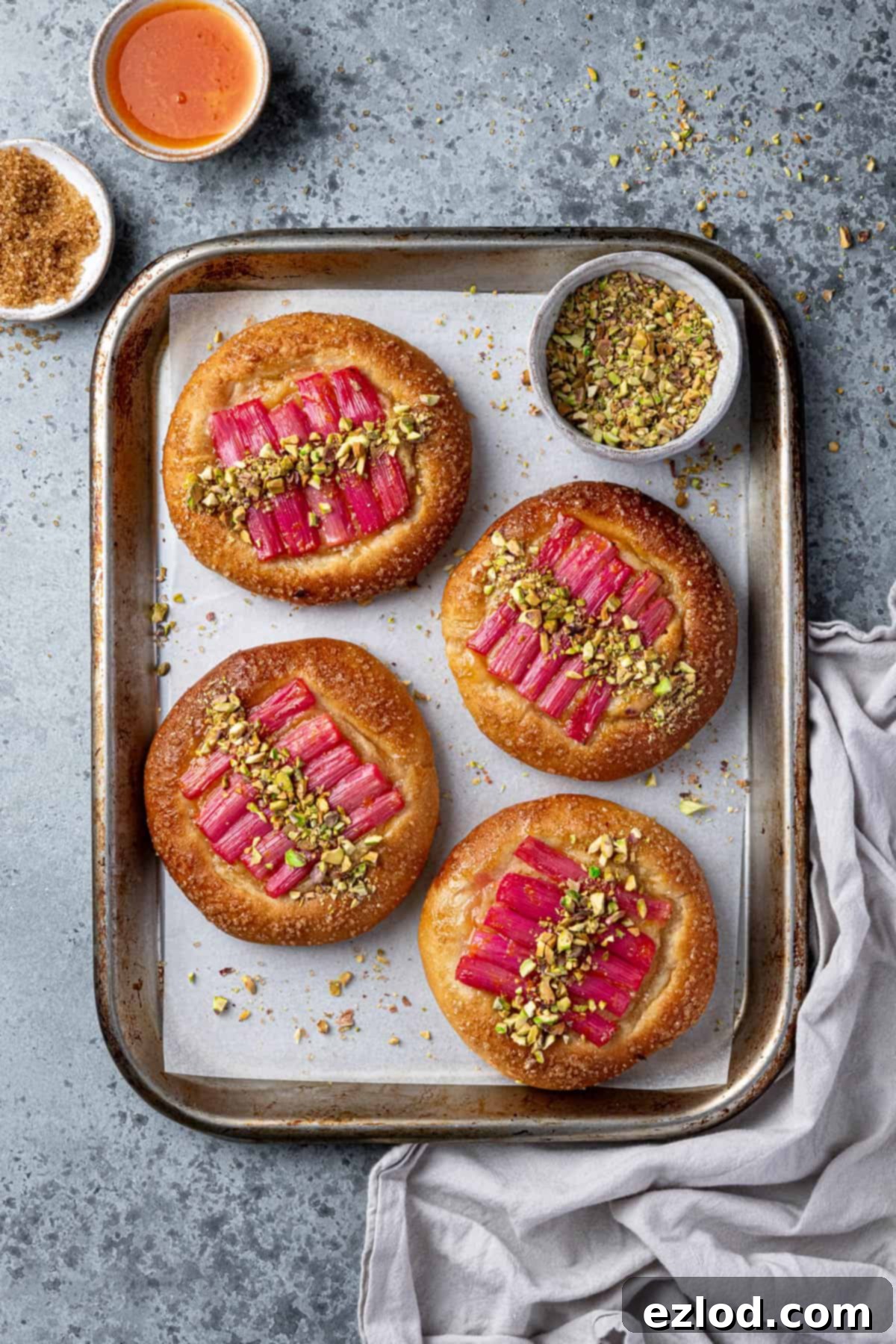
Top Tips for Baking Flawless Vegan Rhubarb Frangipane Buns
Achieving bakery-quality vegan rhubarb frangipane buns is easier with these expert tips:
- Precision in Measurement: As with all my baking recipes, I wholeheartedly recommend using metric measurements with a digital scale instead of volumetric cup conversions. Cups are notoriously inaccurate, and precise weighing will yield far more consistent and superior results. Plus, it’s often less messy!
- Yeast Freshness: Always double-check the expiration date of your instant yeast. Old or inactive yeast is the most common reason for dough failing to rise, leading to dense, unappealing buns.
- Temperature Matters: The rising time for your dough is highly dependent on ambient temperature. On warmer days, your dough will proof much faster than on colder ones. Keep an eye on it rather than strictly adhering to the stated time; it’s ready when doubled in size.
- Gentle Rhubarb Roasting: Be careful not to overcook the rhubarb during the roasting stage. It should be tender but still hold its shape. Overcooking will make it mushy and difficult to arrange aesthetically on the buns.
- Overnight Proofing Option: For enhanced flavor development and a more manageable baking schedule, consider giving your dough its first rise overnight in the refrigerator. The slow, cold fermentation deepens the flavors of the bread, and you can finish the buns the next day.
- Serving Freshness: These vegan rhubarb frangipane buns are undoubtedly at their absolute best when enjoyed on the day they are baked. However, they will remain delicious for a couple more days if stored correctly. A quick warm-up in a low oven or microwave just before serving will refresh them beautifully.
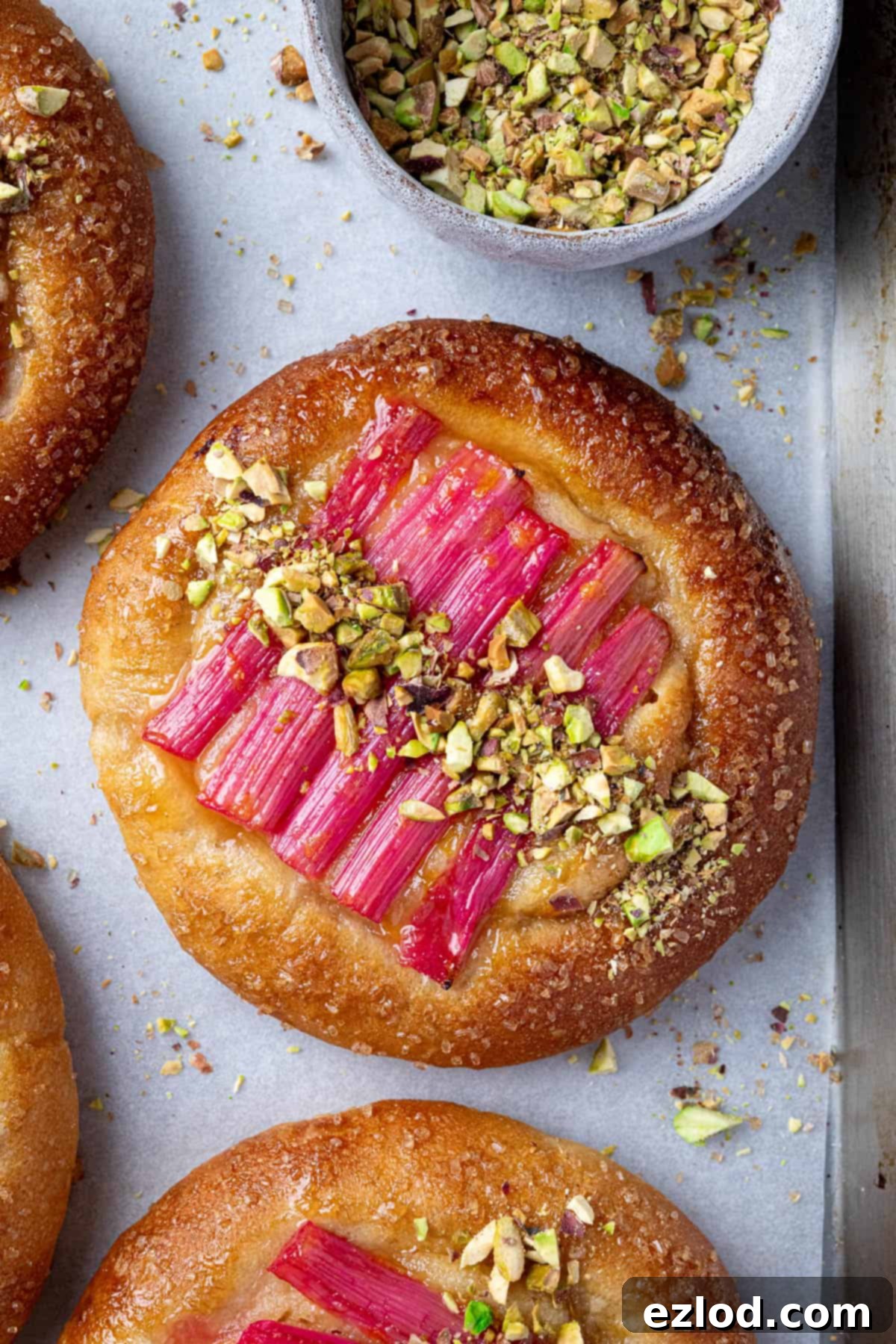
Frequently Asked Questions (FAQ’s) About Vegan Rhubarb Frangipane Buns
For optimal freshness, store the cooled buns in an airtight container at a cool room temperature for up to two days. If your kitchen is particularly warm, it’s best to store them in the refrigerator to prevent spoilage. You can gently warm them before serving to bring back their freshly baked appeal.
This tangzhong dough is intentionally soft and a bit sticky, making a stand mixer with a dough hook the easiest method for kneading. However, you absolutely can knead it by hand if you don’t have a mixer; just be prepared for a slightly messier process. When hand-kneading, avoid adding excessive flour to your work surface, as this can dry out the dough. Instead, lightly oil your hands and the work surface if the dough becomes too sticky. A bench scraper is an invaluable tool for unsticking dough from the surface and folding it during manual kneading.
Yes, the baked rhubarb frangipane buns freeze wonderfully! Ensure they have cooled completely before freezing them on the same day they were baked to lock in freshness. Store them in an airtight container or individually wrapped to protect against freezer burn. When you’re ready to enjoy, allow them to defrost at room temperature, then refresh them in a low oven (around 160°C/325°F) for 5-10 minutes, or in the microwave for 10-20 seconds. I do not recommend freezing the buns before baking.
Unfortunately, this specific recipe is not suitable for gluten-free flour substitutions. Achieving a light, fluffy bread texture without gluten is a complex process, and this recipe is specifically designed around the gluten structure of wheat flour. Successfully making gluten-free bread requires a complete recipe re-formulation, which is outside my area of expertise. For gluten-free baking, it is always best to seek out recipes that are specifically developed and tested to be gluten-free, rather than attempting to adapt a non-gluten-free recipe.
Absolutely! These frangipane buns are incredibly versatile and would be equally delicious with a variety of other fresh fruits. Consider using blueberries, sliced peaches, or fresh strawberries for a delightful twist. Unlike rhubarb, most other fruits do not require pre-cooking; simply arrange the fresh fruit directly on top of the frangipane before you bake the buns. Adjust baking time slightly if needed, keeping an eye on the fruit.
More Delicious Vegan Sweet Bun Recipes to Explore
If you’ve enjoyed making these vegan rhubarb frangipane buns, you’ll love these other plant-based sweet bun recipes, perfect for any occasion:
- Vegan Belgian Buns
- Classic Vegan Cinnamon Rolls
- Traditional Vegan Hot Cross Buns
- Decadent Banana Bread Cinnamon Rolls (Vegan)
- Refreshing Vegan Lemon Blueberry Rolls
- Indulgent Chocolate Orange Hot Cross Buns
- Spiced Vegan Gingerbread Cinnamon Rolls
- Hearty Wholemeal Maple Cinnamon Rolls
- Rich Mocha Cinnamon Rolls
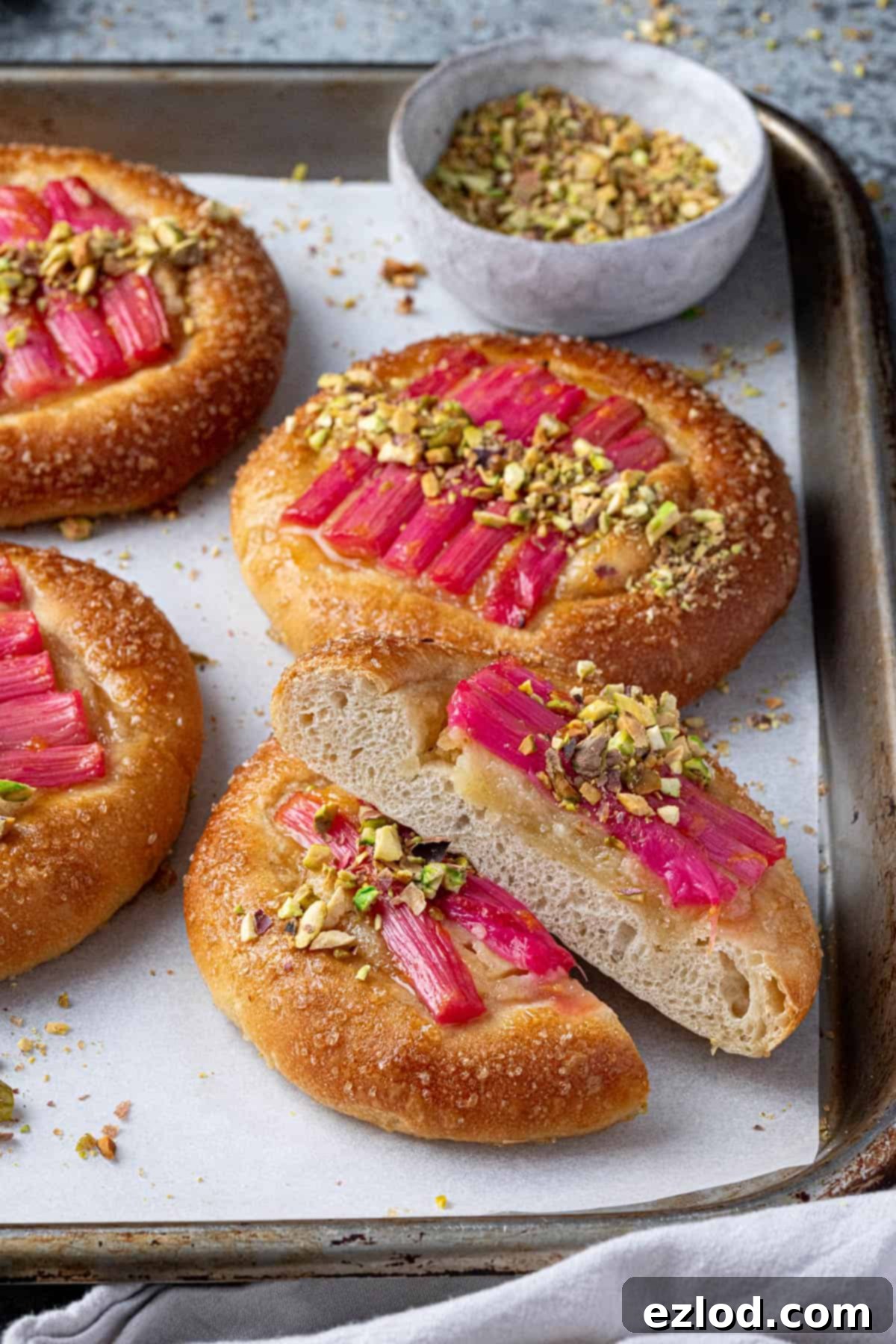
If you’ve had the pleasure of trying this wonderful recipe, I would absolutely love to hear about your experience! Please take a moment to rate it, leave a comment below sharing your thoughts, or tag @domestic_gothess on Instagram and use the hashtag #domesticgothess. Your feedback helps me improve and inspires others to bake!
All images and content published on Domestic Gothess are protected by copyright. If you wish to share this recipe, please do so by utilizing the provided share buttons. We kindly request that you do not screenshot or reproduce the recipe or content in its entirety. Instead, please include a direct link back to this post for the complete recipe. Your understanding and cooperation are greatly appreciated.

Rhubarb Frangipane Buns (Vegan)
Ingredients
Tangzhong:
- 25 g (3 Tablespoons) white bread flour
- 140 ml (½ cup + 4 teaspoons) unsweetened non-dairy milk (I use soy)
Dough:
- all of the tangzhong
- 140 ml (½ cup + 4 teaspoons) unsweetened non-dairy milk (I use soy) cold
- 40 g (3 rounded Tablespoons) caster or granulated sugar
- 2 teaspoons vanilla extract
- 360 g (3 cups) white bread flour
- 1 teaspoon salt
- 7 g (1 sachet) fast action (instant) yeast
- 50 g (¼ cup) vegan butter softened
Rhubarb:
- 250 g (9 oz) forced rhubarb
- 25 g (2 Tablespoons) caster or granulated sugar
- juice of 1 small orange
Frangipane:
- 100 g (1 cup) ground almonds (almond flour)
- 30 g (¼ cup) plain (all-purpose) flour
- 10 g (1 Tablespoon) cornflour (cornstarch)
- ¼ teaspoon baking powder
- 70 g (⅓ cup) caster or granulated sugar
- 50 g (3 Tablespoons + 1 teaspoon) vegan block butter melted
- 50 ml (3 Tablespoons + 1 teaspoon) unsweetened non-dairy milk (I use soy)
- ½ teaspoon almond extract
To Finish:
- 1 Tablespoon non-dairy milk
- 1 Tablespoon maple syrup
- demerara sugar for sprinkling
- chopped roasted pistachios optional
Instructions
-
To make the tangzhong, place the flour in a saucepan and gradually whisk in the milk to avoid lumps.
-
Place the pan over a medium/low heat and whisk constantly until the mixture has thickened to a paste/pudding-like consistency.
-
Scrape the tangzhong into the bowl of a stand mixer fitted with a dough hook and pour the rest of the cold milk on top. This will cool the tangzhong down so that the heat doesn’t kill the yeast.
-
Add the vanilla, sugar, salt and flour and finally the yeast. Stir until it forms a rough dough then set the stand mixer to a medium speed and mix until the dough is smooth and stretchy, this can take about 10 minutes.
-
Add the vegan butter and knead for about another 5 minutes until it is fully incorporated and the dough is smooth, elastic and no longer feels greasy. You may need to scrape down the sides of the bowl a couple of times.
-
The dough should still be soft and sticky, but it should pull away from the sides of the bowl cleanly. If it seems too wet then you can knead in a little extra flour, a tablespoon at a time. Be careful though, this is meant to be a soft dough and adding too much extra flour will make the bread dry.
-
Place the dough in a lightly oiled bowl, cover and place in the fridge to rise overnight, or in a warm spot for 1-2 hours, until doubled in size.
-
While the dough is rising, heat the oven to 180℃/160℃ fan/350℉/gas mark 4. Cut the rhubarb into approximately 7cm long pieces and arrange them in a single layer in a roasting tin. Sprinkle with the sugar and pour over the orange juice. Roast for 10 minutes until softened but still holding their shape. Set aside to cool.
-
Punch down the risen dough and give it a brief knead to knock out any air bubbles. Divide it into 10 even pieces (use a scale for accuracy) and roll them into balls.
-
On a lightly floured surface, use your hands to flatten each ball into a disc about 10cm wide, then use your fingers or the base of a glass to flatten the middle section of the disc even further, leaving an approx 2 cm rim around the edge.
-
Place the discs well spaced apart on two lined baking sheets. Loosely cover and leave to rise until puffy, about 30-45 minutes. If you gently press the dough with your finger it should spring back slowly, and maybe leave a slight indentation. If it springs back quickly then it needs a little longer, and if the dough deflates then it is over-prooved so keep an eye on it!
-
While the buns are rising make the frangipane. Stir together the ground almonds, flour, cornflour, baking powder and sugar. Add the melted butter, milk and almond extract and stir with a balloon whisk until combined.
-
Once the buns are done rising, divide the frangipane between them, spooning it into the hollows and spreading it level.
-
Top the frangipane with the rhubarb, reserving the juices for later. Mix together the milk and maple syrup then gently brush this mixture on the exposed rim of dough. Sprinkle with demerara sugar.
-
Bake the buns for 20-25 minutes until nicely browned.
-
While the buns are baking, pour the reserved rhubarb juice into a small pan and bring up to a simmer. Cook for a few minutes until it has reduced slightly then remove from the heat.
-
Gently slide the baked buns onto a wire cooling rack and brush the rhubarb with the syrup. Sprinkle with chopped pistachios if you like and serve asap.
Notes
- For comprehensive tips, detailed ingredient information, and step-by-step photos that guide you through each stage of the baking process, please refer to the main article above. Many common questions regarding the recipe are also addressed there!
- To ensure the most consistent and accurate results in your baking, I strongly advocate for using a digital scale and metric measurements rather than cup conversions. Volumetric measurements can be inconsistent, whereas precise weighing guarantees better outcomes and a more enjoyable baking experience.
- When roasting the rhubarb, exercise caution to avoid overcooking. The goal is for the rhubarb to be tender yet retain its structural integrity, which is important for decorating the buns aesthetically.
- Don’t forget to reserve the rhubarb juices after roasting. Reducing these juices creates a beautiful, flavorful syrup perfect for brushing over the baked buns, adding an extra layer of sweetness and shine.
